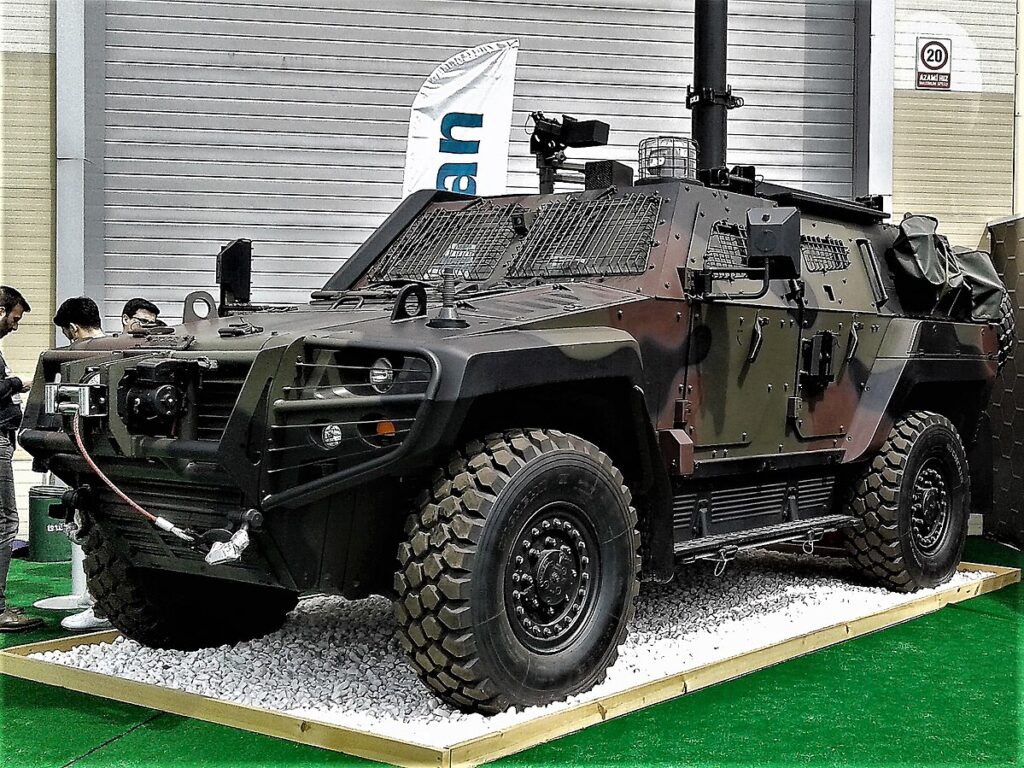
Turkish defense company Otokar announced on Friday that it has been selected to proceed with negotiations for a major sale of armored vehicles to the Romanian Army, as the eastern European country makes strides to modernize its Armed Forces in wake of the Russian invasion of its neighbor Ukraine.
Otokar presented its Cobra II 4×4 armored vehicle to fill the Romanian armored vehicle requirement, submitting a bid in March 2024, the company said in a statement. “After the completion of the technical evaluation, field test, and commercial evaluation processes, the official contract negotiation invitation letter was sent to Otokar by the tender authority,” the statement added. Should it win a contract, Otokar will supply up to 1,059 Cobra IIs to the Romanian Army, which would be acquired in several phases. The initial batch of 278 will be produced in Turkey, while the rest are to be manufactured at a plant in Romania. Ahead of selecting the Cobra II, Romania also examined the Oshkosh JLTV — dozens of which are already on order for and being delivered to Romanian special operators — as well as the Arquus Sherpa to fill the 4×4 requirement.
Romania’s selection of Otokar is a significant win for both the company specifically and Turkey’s arms export strategy generally. As part of its broader industrialization effort, the Turkish government has worked to drum up defense sales, in particular promoting Turkish armored vehicles, artillery systems, and drones to militaries in the Middle East, Africa, and Europe. Turkish arms exports rose to a record high $5.5 billion last year, growth of about 25 percent over 2022. For Otokar, the proposed sale to Romania could be worth as much as RON4.26 billion ($940 million), which Turkish media reported would be worth over 80 percent of the defense company’s combined revenue for the last four quarters. After Otokar’s announcement, the company’s stock rose 10 percent on the Borsa Istanbul, Turkey’s stock market.
The 4×4 armored vehicle competition, launched in May 2023, is one of several key procurement projects on the Romanian military’s agenda geared towards improving Romanian deterrence while deepening interoperability with Bucharest’s NATO allies. As elsewhere in Europe, Russia’s invasion of Ukraine in 2022 has served as a major impetus for the Romanian government to address its aging force structures, worried over the prospect for a direct confrontation with Moscow. Romania has faced the risk of spillover from the conflict as Russia conducts strikes on Ukrainian population centers near the border with Romania, and last month’s Russian airstrike on a Ukrainian cargo vessel in the Black Sea reportedly happened in Romania’s exclusive economic zone.
The Romanian Ministry of Defense is presently entertaining bids for a separate infantry fighting vehicle (IFV) competition, which could turn into an order for nearly 300 IFVs, as well as a main battle tank tender. In July, Romania inked a $1 billion contract with South Korea’s Hanwha Aerospace for 54 K9 Thunder 155mm self-propelled howitzers and dozens of K10 resupply vehicles. Romania is also beefing up its Air Force, planning to introduce 32 F-35A fighter jets in the coming years, along with new Patriot missile systems. On October 7, Romania was approved for the purchase of four AN/MPQ-64 F1 Sentinel air-surveillance radars.
While Romania has an urgent need to rearm, the country must do so with a relatively-limited defense budget. Romanian defense spending has certainly seen dramatic growth over the last decade, rising from around $2.7 billion in 2014 to over $8.6 billion in the current-year budget. And, according to NATO’s figures, annual Romanian defense outlays are now over 2.25 percent of GDP — well above the 1.4 percent of GDP average a decade ago. The impressive level of growth has enabled Romania to move forward with new arms contracts, but the scale of the country’s requirements, along with ballooning prices for military equipment, has led to delays in finalizing some agreements.
The F-35 acquisition, for example, is valued at $7.2 billion in total. While this cost will be paid out over a period of years, it amounts to around 84 percent of Romania’s entire defense budget for FY24. To take another example, in May 2023, Romania’s government green-lighted the purchase of M1A2 Abrams main battle tanks, estimating that the 54 used models would cost around $1.1 billion. But when the U.S. announced approval for that sale on November 9 last year, the DSCA estimated the value of the 54 tanks to be $2.5 billion, more than double Romania’s projections. Romania has thus sought funding support from suppliers to fulfill its procurement agenda. The U.S. last month announced a $920 million foreign military financing loan to Romania, to help it purchase the U.S.-made equipment, and Romania has applied for E.U. funding for recent defense projects, as well.
But another angle is to boost the benefit to the Romanian economy through securing local workshare, such as with the proposed Cobra II acquisition that could see Romania produce nearly 75 percent of the total order itself. Arms agreements that involve the participation of the importer’s domestic industry, rather than straight ‘off-the-shelf’ sales, are not always possible to reach for political or technical reasons — particularly for the most advanced kit on global markets — but where doable, localized production deals support domestic jobs, while keeping some budgetary costs at home. Romania like many of its neighbors has thus pursued technology transfer and joint production when negotiating its recent defense contracts. This growing emphasis on national defense industries has, in turn, boosted the prospects for suppliers like Turkey to break into international markets and establish themselves as key global defense players.
Military markets analyst, covering Eurasia, Middle East, and Africa.



